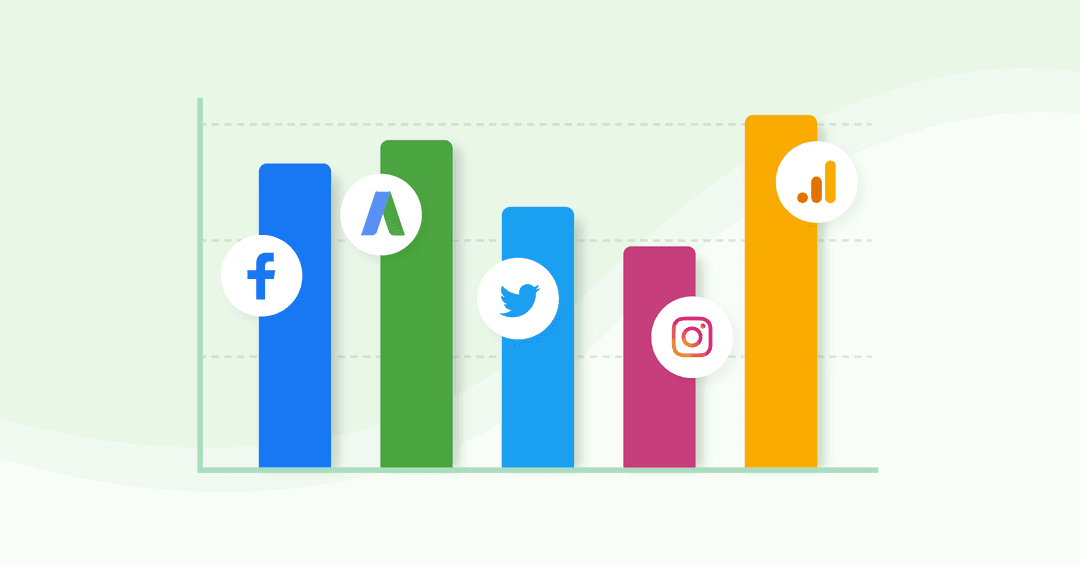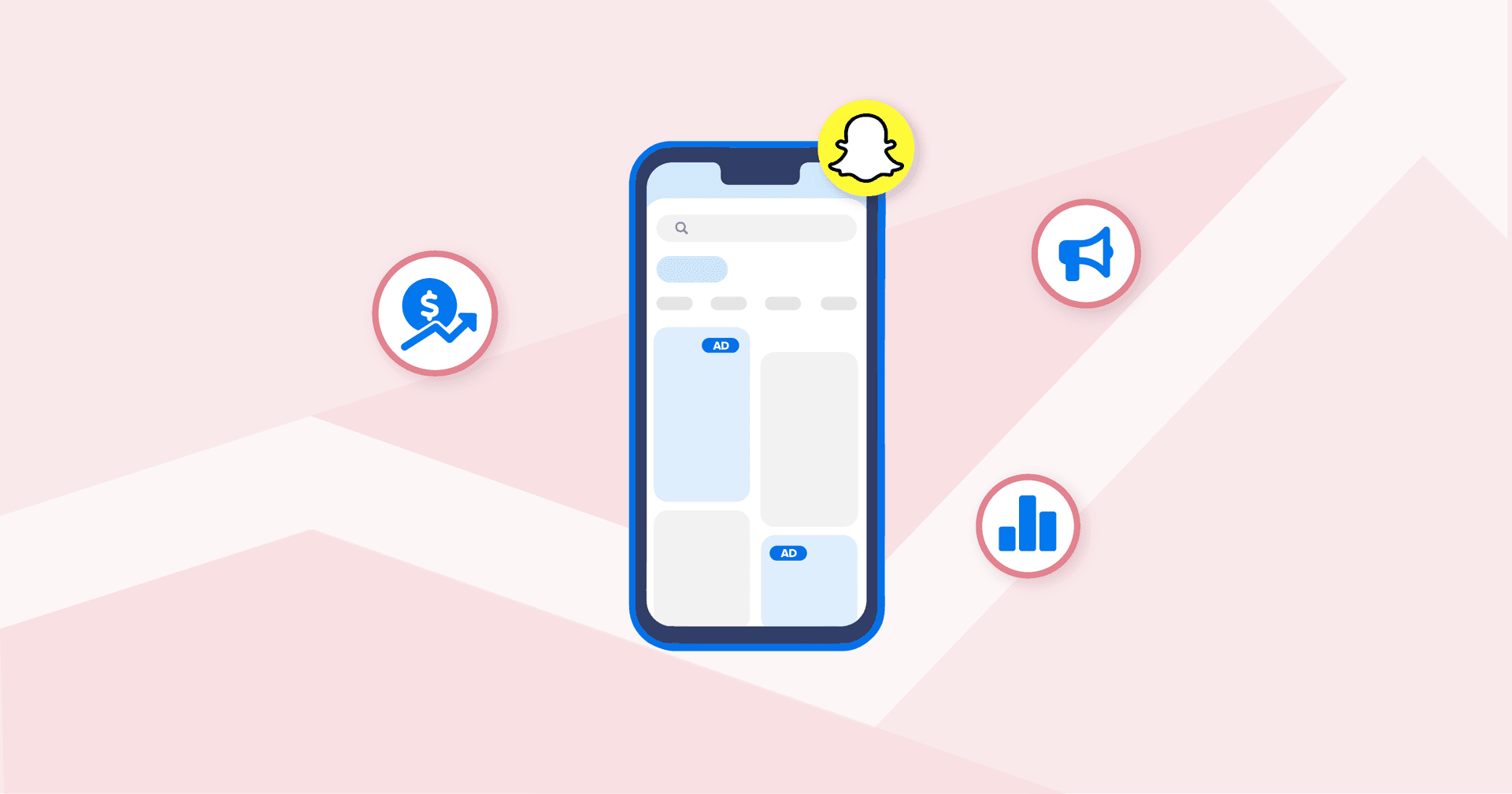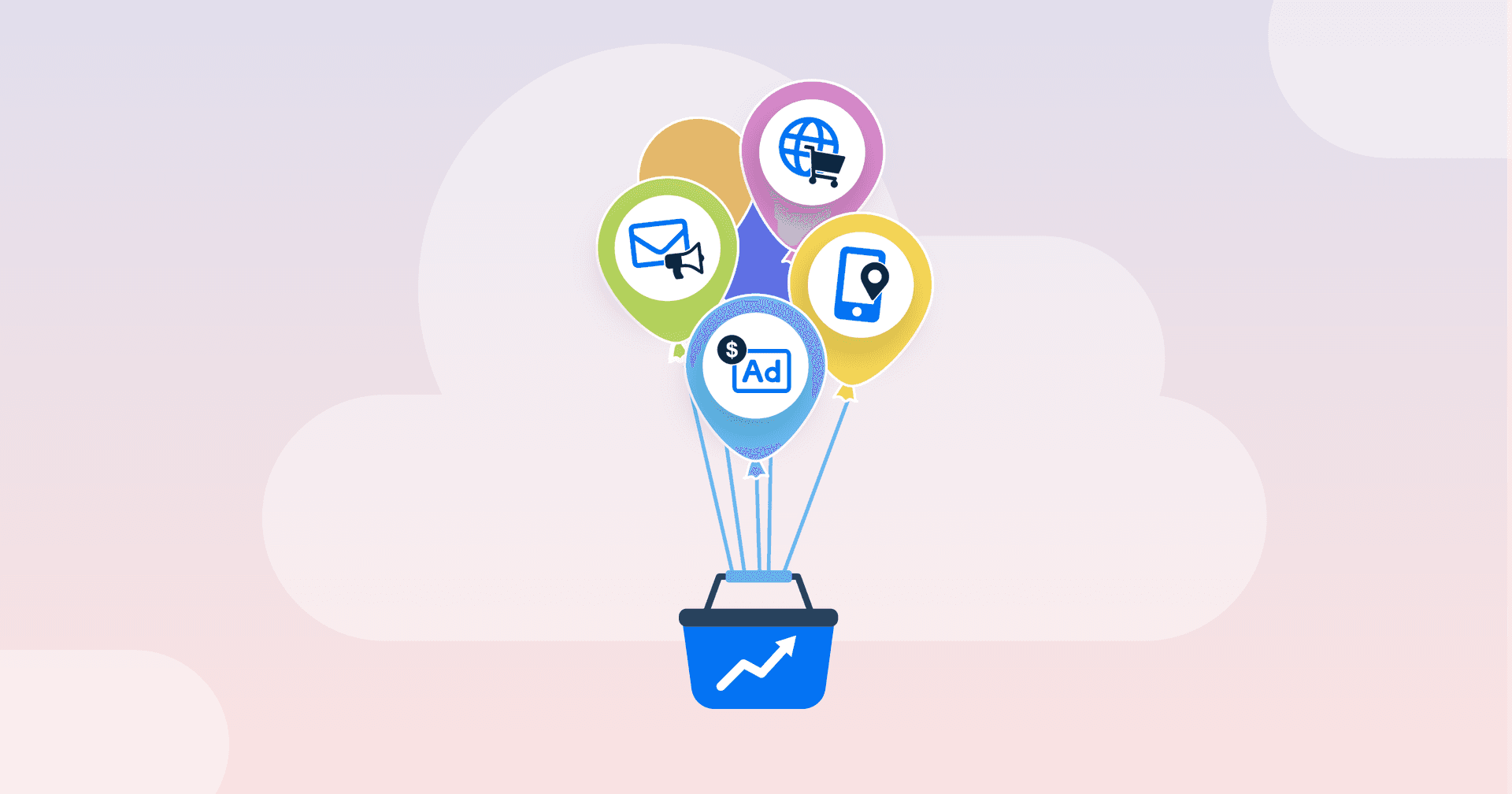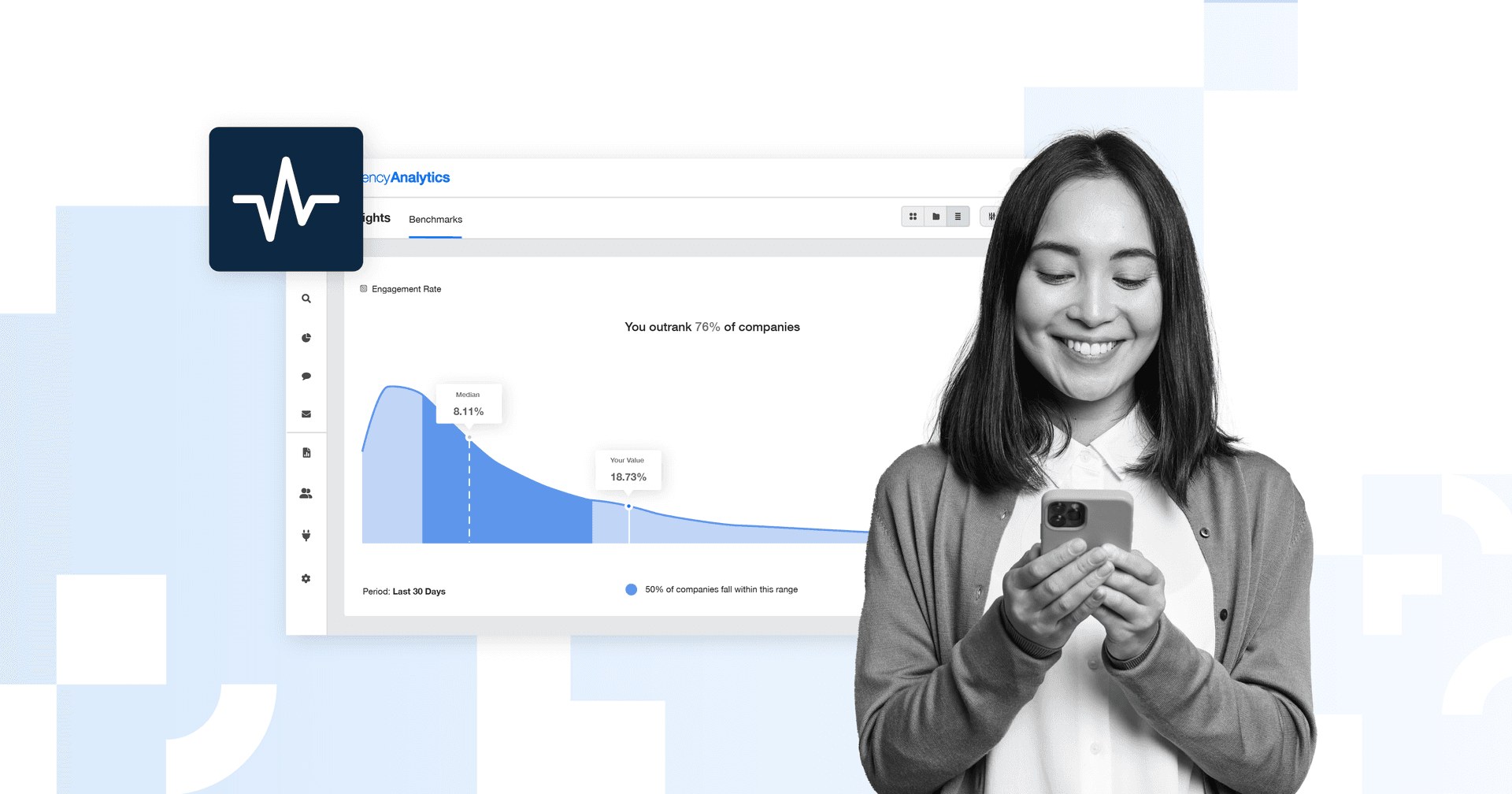Table of Contents
If you wonder how your client reporting performance compares to your agency peers, you’ve come to the right place. We've analyzed data from over 3.8M active reports, 143.5K campaigns, and 7,000 agencies to create the 2022 Client Benchmark Report for Agencies.
Now that’s what we call a sample size!
We've also included insights from some leading marketing agencies, on tricks of the trade to optimizing the reports that larger agencies send out to clients.
This article will look at client reporting trends in 2022 to help you demonstrate your agency’s ROI month over month, optimize client reporting, scale your agency, and stay ahead of the curve. We’ll cover how to:
Send client reports on days and times they’re most likely to open it
Understand essential industry insights from top agencies about reporting best practices
Improve your existing client reporting process and structure to save valuable time in the long run
Realistically plan for your agency’s growth and increased reporting demands
Effectively communicate the ROI of reporting to your clients
Why Your Agency Needs Client Reporting
Amid continuous change, your clients still expect consistency in reporting (and rightfully so). After all, making strategic decisions without being informed by data is like blindly swinging a bat.
Making client reports may not seem like the most exciting part of your day-to-day operations, but it’s arguably the most important.
Here’s why you shouldn’t skim on your client reporting.
Client Reporting Maintains Consistency
The demands on agencies are dynamic and evolving. In the marketing landscape, there’s always a new update (take, for example, Google’s G4 changes or the ongoing Facebook ODAX rollout) and other evolving trends to keep on top of. More than ever, agencies are tasked with keeping up with these changes and ensuring a steady ROI for their clients.
How exactly do you do that in a constantly evolving environment? Reporting.
Without the data to inform your agency’s decision, it’s a shot in the dark when you’re rolling out campaigns with no real substance or feedback loop.
Clients hire a digital marketing agency to get improved results from their website or marketing initiatives. You can't improve what you don't track.
Nathan Hawkes, President at Arcane Marketing
Automated Reporting Saves You Time and (Creative) Energy
Depending on where you are in your agency’s organizational chart (perhaps you’re the Marketing Manager, Account Executive, Art Director, or Social Media Coordinator), your role may be heavily based on managing an agency account's creative and developmental aspects.
Making that left-brain switch to the analytic side of things is particularly challenging in these instances. That’s where an automated reporting tool swoops in to save you time, energy, and tedious data-pulling. On average, agencies save 137 billable hours per month from automating their client reports—that could be you, too! Report automation also positions your agency for scaling success as you juggle the increasing demands that come from growth. Don’t wait till things get unmanageable. Buffer yourself from opportunity loss by leveraging efficient reporting early on.
Lorianna Sprague, Vice President of Marketing at Trusted Search Marketing, notes, “AgencyAnalytics has reduced the total time spent on reporting by many hours each month. Now we don't have to spend time building and can focus on doing.”
Agency Tip: If you’ve got clients in the same or similar-type industries, create a standardized reporting template to repurpose easily. No need to reinvent the wheel– only tweak where necessary. This will save you time on your client reporting process in the long run.
And as Terrence Gordon, CEO at Pl8ted says, “The ability to duplicate reports has saved us a tremendous amount of time. Our services are steady, so we rely on getting a client up and running as soon as they come aboard.”
11 Client Reporting Benchmarks Your Agency Needs to Know
Over 16K agency employees and nearly 98K client users have AgencyAnalytics as their go-to reporting platform.
Here are the key insights we observed from their usage and reporting habits over the past year.
1. The Average Open Rate for Client Reports is 54% And the Average Click Rate is 29%
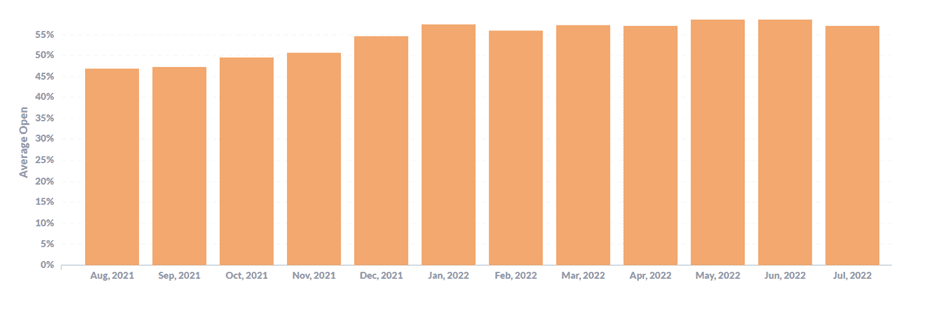
Not too shabby! After you’ve done your due diligence as an agency by sending a client report, you may wonder whether they’ve opened it or clicked on any important links. While you may look at a 54% open rate as ‘46% of clients haven’t opened their reports’, it still means that most clients want to know how their campaigns have been performing. It also shows that your agency goes above and beyond to deliver top-notch service– so don’t stop sending those clients reports.
Agency Tip: When sending reports through the AgencyAnalytics platform, track who has and has not opened their reports. If your clients do not review their reports, it can be an early warning sign of potential churn. Take this opportunity to mediate that churn risk.
It’s also interesting to note that the open rate for client reports has been steadily climbing, indicating that clients are paying closer attention to an agency’s metrics during the current economic climate.
2. The Best Time to Send a Client Report Is Between 9:00 - 9:30 AM On a Tuesday or Thursday
When reports are sent between 9:00 - 9:30 AM, most agencies experience a 47 - 62% open rate, which is essential to note when sending a client report.

This time window of 9:00 - 9:30 AM also corresponds to a significantly higher click rate of 15 - 24% (making it the most optimal time to send a client report).

As you can see, the second highest open rate of 50 - 56% is observed between 5:00 - 6:00 PM, corresponding to a click rate between 15 - 17%.
After 6:00 PM, there’s a steady decline in both open and click rates as many clients are likely winding down from their packed schedules. Interestingly, open rates range from 43% to 50% after hours between 11:45 PM - 5:00 AM. It may be one of the few time pockets your busy client has to review their report (we won’t recommend sending a report at an odd hour, though).
Or it could mean your clients are opening reports a short while after it’s sent (if you opt for a later send time, that is).
Whichever time you send your client’s report, don’t be surprised if those open and click rates aren’t racking up immediately. Good things take time.
The days with the most favorable open rates are Tuesdays and Thursdays (both have an average of 58% open rates). Write this on a Post-It for later!
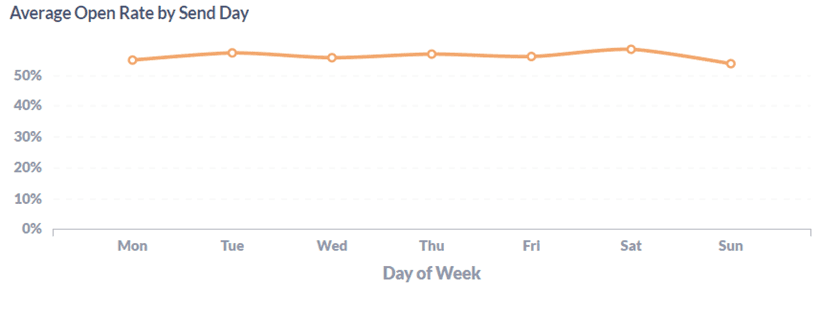
Wondering why this may be? Perhaps your clients usually catch up on e-mails and work chats on a Monday, so they are distracted by other communications. Approaching the end of the week, they may be winding down and closing out any outstanding items before the weekend hits.
Therefore, it makes sense to catch them on a Tuesday or Thursday when they’re in the mid-week groove and are most likely to open the marketing report you send.
3. Enterprise-Level Agencies Send Almost 5X More Monthly Client Reports Than Mid-Size Agencies
Not surprisingly, the number of client reports your team will need to create and send will grow, especially if you’re looking to onboard new clients and take your agency to the next level. More clients mean more reporting needs.
On average:
Mid-size agencies send 2X more monthly reports than freelancers on the AgencyAnalytics platform
On average, approximately 30 monthly client reports are sent out by enterprise-level agencies, compared to an average of 6 monthly reports at the mid-size agency level.
Wondering what this means? Let’s break it down:
As you move from a freelancer to a mid-size agency, you’ll be sending approximately double the number of client reports per month.
Agencies that scale to the enterprise level should expect significant exponential growth in the number of client reports delivered each month.
Agency Tip: As your mid-size agency grows, a systematic client reporting process is undoubtedly needed. Growth has a snowball effect, and other considerations must be made (such as the number of required resources, the expected cost of overheads, or even finding a larger office space). With this numerical insight, plan and estimate your future business needs to keep things progressing. Invest in reporting tools such as AgencyAnalytics to save time and automate the entire process.
To back this up with data, you can see that the higher-tier AgencyAnalytics plans correspond to busier agencies. Boutique agencies that typically use the Freelancer plan have an average of just under five clients.
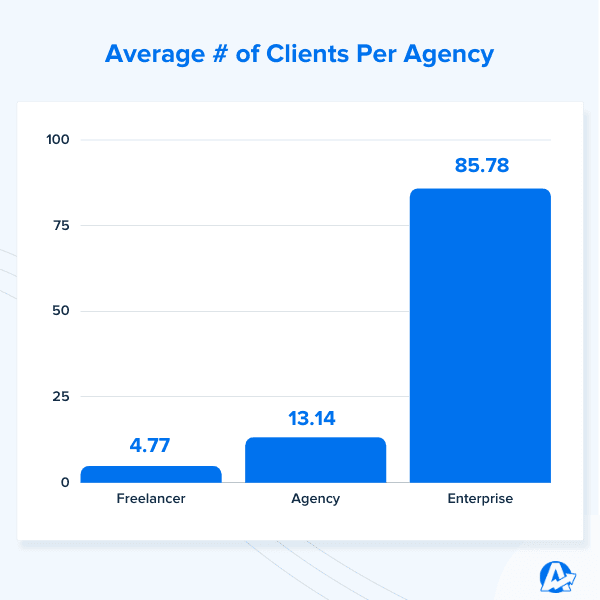
As they scale to a mid-size agency, that number nearly triples, with the average coming in just above 13 client campaigns. However, larger agencies on the Agency Pro plan are the ones who have seen exponential growth, averaging nearly 86 client campaigns within their account.
4. Agencies Send a Mix of Fully Automated, Partially Automated, and Manual Reports
As we can see below, on average, agencies utilize a mix of automated and manual reports through the AgencyAnalytics platform.

We also compiled the total number of agencies that sent manual or automated reports (or both) over the past year.

As Jamie Contreras, CEO of Optemyz Solutions, explains, reviewing the reports before they are sent “allows our account managers to provide an overview of the report in email, video or over the phone. It makes it more personal, and our clients really like the recap. Many do not even look at the full report, so we make it easy for them to understand the main takeaways and account performance.”
While it’s hard to rival the ease of automated reporting tools, there are a few instances where adding additional commentary, annotations, and insights come in handy before sending a report to a client. Got busy clients who want just high-level, succinct updates? Adding a snapshot or executive summary does the trick here.
We like to personalize the summary piece of the report each month. It is helpful to have the majority of the report completed; all we have to do is update the summary piece of it. Perfect balance!
Ariene Dionela, Digital Media Account Director, Connections Marketing
That extra communication buffer demonstrates your agency’s commitment to excellent customer service, customizing the reporting process, and ensuring your clients fully grasp the ROI of their marketing efforts (without getting lost in complex jargon or a mountain of numbers). As Michael Smith, Senior Digital Manager at EOS Healthcare Marketing, puts it, “Communication keeps clients. By providing a regular report via email, and easy access to talk to us, we can highlight our success while addressing any concerns before they become problems.”
Similar to having availability and ease of communication, there are instances where your agency may want to add a few notes and detailed observations. While marketers know the ins and outs of social media and web analytics, sometimes you have to break it down in more layman's terms for your client.
After all, they’re busy running a business and may not have the time to search for the nitty-gritty details of marketing analytics.
We always review the data, making specific recommendations that will be of value to the client. Data can be so in-depth and often needs context to evaluate how effective the campaign is, what needs to be adjusted and how it impacts the long-term goal.
Valerie Jennings, CEO, Jennings Social Media & MarTech
Agencies are customer-oriented businesses that go the extra mile for their clients. Sending a report with annotations (such as noting when changes were made, ideas for future campaigns, or recommended areas of improvement) often does the trick for a client who prefers a personalized reporting process. In contrast, an automated monthly overview works better for those who just want the data.
5. On Average, Agencies Track 45 Keywords Per Client
Keywords are king when it comes to maximizing your client’s search ranking potential. A solid SEO strategy is a gift that keeps on giving! And even if your agency is not currently handling a client’s SEO campaigns, understanding the organic performance of top keywords helps inform the overall marketing strategy.
Our data shows that–when keywords are being tracked for a client–the average number of keywords is 45.39. (Note that this average only includes client campaigns where the Keyword Rank Tracker has been integrated.)
Interestingly, although the range can be quite vast–anywhere from a dozen to thousands of keywords–the average stays reasonably consistent no matter the agency's size, ranging from 36.31 keywords tracked on the Freelancer plan to 48.96 keywords tracked on the Agency Pro plan.
As an SEO consultant, accurate client reporting is essential to evaluate how well various SEO strategies work. To retain my clients, I need to be able to show them that their rankings are improving over time.
Kelly Fitzgerald, Founder of Savvy Marketing Services
As you continue to monitor keyword trends over time on the AgencyAnalytics platform, see what number of keywords works optimally for your individual clients and keep an eye on any new possible combinations.
6. The Top 3 Dashboards Used Are: SEO, Digital Marketing, and Google Ads
Use the marketing dashboards to customize which analytics and metrics appear at the top of your client’s reporting snapshot. Quickly review important numbers so you (or your client) can decipher what’s happening within any given marketing campaign.
As Ashlee Brown, Campaign Performance Manager at i76 Solutions, says, “We utilize our dashboards for much more than reporting; we use them to keep our eyes on campaigns and their key performance indicators around the clock and think our clients should be able to. You can't hide behind dynamic data, so in a way, it pushes us to be the best we can.” On average, agencies have 18 dashboards on their reporting interfaces (to give you an idea of how many platforms are used).
Agency Analytics has both helped us internally as an agency, as well as our clients. Many times, our clients were tired of clicking into 13 different dashboards to gather data from each platform. With Agency Analytics, all of the data is in one place, which has proved to be very beneficial for both us and our clients.
Christopher Marrano, Founder & CEO of Blue Water Marketing
7. The Top 3 Reporting Sections Used Are: Keyword Rankings, Google Analytics, and Google Business Profile Insights
Over the past year, agencies have tracked:
540,651 keyword rankings
306,054 Google Analytics insights
261,614 Google Business Profile Insights
That’s over 1M insights (and those are just our top 3 most used sections)! This makes sense and ties into our top-used dashboards–and we see why. Staying on top of your client’s SEO game is like operating a well-oiled machine. You must keep track of all the moving parts (such as Google Analytics and Google Business Profile) to keep it moving optimally.
Dashboards also give real-time developments, enabling flexibility and agility for on-demand requests.
Instead of sending automated reports, I review my client's dashboards prior to sending them their monthly scorecard. This allows me the flexibility to bring in additional information as needed.
Kelly Fitzgerald, Founder, Savvy Marketing Services
8. Agency Clients Log Into the AgencyAnalytics Platform Almost 2 Times per Week on Average
The AgencyAnalytics client login feature comes in handy for those who don’t want an end-of-month reporting process or frequently require real-time, on-demand access to their data. It gives clients the autonomy to track their marketing efforts as needed and monitor any notable changes without having to wait for a report or reach out to you directly.
And it certainly has been helpful as, on average, clients log into the AgencyAnalytics platform almost 2 times per week. This has steadily increased over the past few months, so it’s a feature your agency should consider using.
AgencyAnalytics client accounts have been created by:
76% of enterprise-level agencies,
60% of mid-size agencies, and
37% of freelancers.
Expect to onboard more client login accounts as your agency scales to an enterprise level. High-ticket clients come with significant budgets and are understandably invested in the performance of their marketing campaigns, so it’s no surprise they want to be kept in the loop more regularly.
9. The Average Client Campaign Includes 4.31 Marketing Platform Integrations
When working with a myriad of marketing platforms, wouldn’t it be convenient to have all that data in one place? The seamless integration feature incorporates all your most used platforms in an easy-to-use, intuitive dashboard setup.
Based on our data findings, here are the key takeaways about integration feature usage:
On average, agencies use 4.31 marketing platform integrations in any given client campaign.
Interestingly, we observed an average of 8.22 integrations per mid-size agency account (almost double the average for integrations used in individual client campaigns above). This indicates that clients often require different marketing platform integrations based on their strategic goals.
Enterprise agency-level accounts have almost 11X more integrations (90.28 on average!) which indicates just how much variety there is in marketing platform integration across a higher volume of clients.
So, what does this mean as your agency scales?
You’ll have to get comfortable with various marketing platforms (if you aren’t already) as you’re more likely to come across clients with varying campaign objectives. By committing to continuous learning and following client reporting best practices, you’ll be well on your way to agency success.
10. The Top 10 Most Used Marketing Integrations
Of the over 80 marketing platforms available, the following are the Top 10 most popular based on the percentage of agencies using this data in their client reports and dashboards.
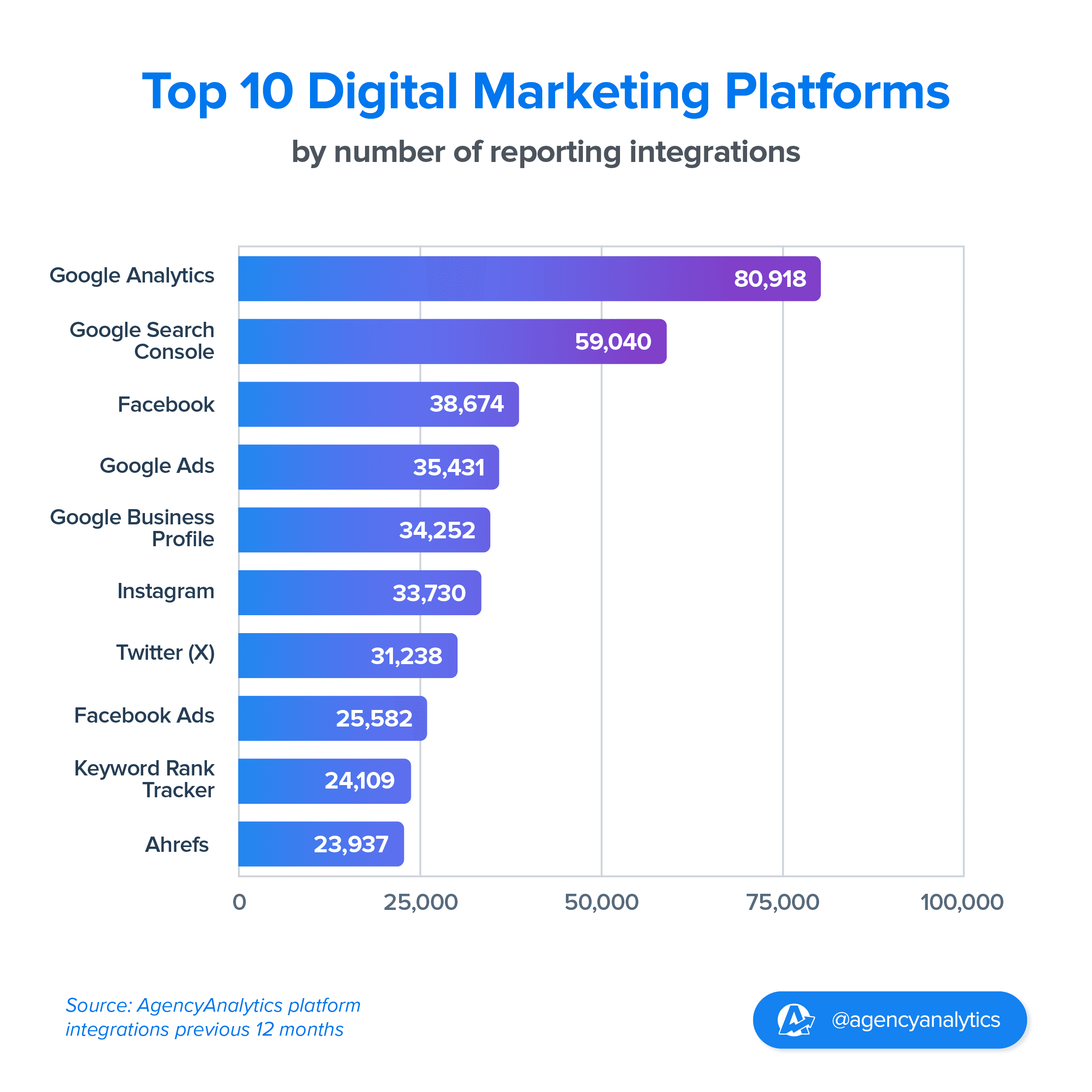
Like dashboard and section usage on our platform, Google takes the clear lead, including Google Analytics, Google Ads, and Google’s in-house SEO tools.
11. Popular Enhanced Client Reporting Features
Agencies typically use enhanced client reporting features to provide an extra depth of insights. The most popular ones are Custom Logos, Multiple White Labeling, Custom Metrics, Goals, and Rank Tracker.
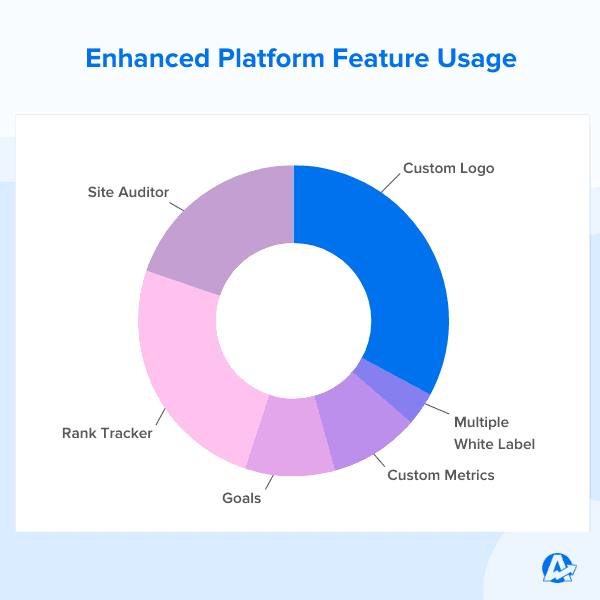
White Label Reporting
Using white label capabilities indicates that–as agencies grow–branding becomes more critical to success. 92% of the top-volume agencies have uploaded their logo to the platform compared to only 71% of smaller boutique operations.
The ability to set up multiple white label profiles is only available on the Agency and Agency Pro plans. This feature allows agencies to set a different branding profile for their internal agency brands or create dashboards and reports branded with their client’s logo and color scheme. 38.5% of agencies utilize this feature to enhance their client reports.
SEO Tools
Larger agencies tend to include SEO data in their reports, whether they manage those accounts for clients or not. Here are some key differences in SEO tool usage based on agency size:
Keyword ranking: Used by 52% of freelancers vs. 83% of enterprise-level agencies
Site Auditor: Used by 39% of smaller agencies vs. 73% of enterprise-level agencies
This tells us (unsurprisingly) that larger agencies have more clients, ad spend, and campaigns to manage. As a result, there's an increased reliance on SEO tools to measure ROI and understand the overall marketing picture.
Custom Metrics & Goals
29% of agencies utilize the custom metric feature, which can take existing marketing metrics and create personalized KPIs (available only on Agency and Agency Pro level plans).
If you’re juggling clients with multiple campaigns at any given time, standard metrics may not paint the picture as colorfully as they should be.
For example, take a client with a range of ongoing campaigns who wants to know their return on ad spend for a particular social media platform. In this scenario, utilizing available data points and plugging them into a custom metric formula gives the precise information your client wants to know.
Goals are used by 15% of agencies to strategize ahead and show tangible progress (again, another feature exclusively on Agency and Agency Pro plans).

How Frequent Should Client Reporting Be?
It varies depending on a couple of factors like the size of your agency and the length of time it takes your campaigns to show changes in results.
The frequency of sending reports really depends on the client and the experience of internal management and/or the owner of the business. Large corporations normally have internal analysts whereas local small businesses do not and are not as hands-on with analyzing marketing data.
Brad Fogel, CEO, Operation Technology
On the one hand, a weekly reporting schedule gives a good overview of shorter campaigns and a snapshot of performance to evaluate for immediate changes.
Valerie Jennings explains the benefit of a weekly report. “Weekly is a good touchpoint timeframe to review what is working and what strategies and tactics need adjustment. Each marketing platform has its own algorithm that changes user behavior. A longer set campaign with several touch points in between allows us to be agile, respond quickly, and see better results.”
On the other hand, if you’re running campaigns that take longer to materialize solid results, opt for a monthly reporting structure.
Sending monthly reports not only helps provide clients with an overview of what was achieved and the progress made within a month but also gives campaigns time to set and normalize. Although it is nice to check in on a campaign weekly, sometimes it is better to get a macro perspective of how the campaign went in order to determine its success.
Ariene Dionela, Digital Media Account Director, Connections Marketing
Notably, most agencies lean more towards monthly reports instead of weekly updates.
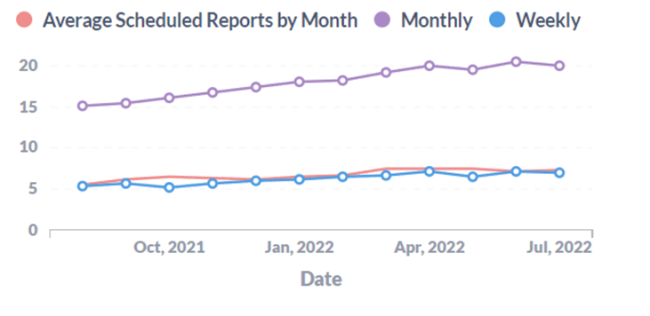
As you can tell, there are pros and cons to each approach. Chat with your client and decide on a frequency that works best while factoring in the campaign type and expectations.
16 Top-Performing Agencies Provide Client Reporting Insights

Don’t take our word for it—hear from marketing agencies like you!
Here’s what top agencies had to say about client reporting and why it’s a non-negotiable when running a successful business.
1. Client Reporting Leads to Client Retention
Our clients are business owners. They have other responsibilities. The reports we send are often the client's only insight regarding performance. If they are inaccurate, clients lose faith, and we lose clients. Showing the correlation between our efforts and the program's performance helps to create informed decisions from both parties.
Monthly reporting provides a good cadence of communication that keeps clients happy and informed without smothering them.
Michael Smith, Senior Digital Manager, EOS Healthcare Marketing
2. Client Reporting Demonstrates Marketing ROI
“Accurate reporting on the proper metrics that actually move the client's needle is crucial. We ensure our clients have access to real-time reports so they're never left in the dark. Then, every month, we sit down with them, go over the numbers, and answer any questions they may have. We want to ensure our clients have easy access to current data that impacts their business.
During the lockdowns of 2020, we had a client who wanted to cut back on marketing because they were experiencing a slowdown. We were able to show them that the customers they were still acquiring were actually coming from the marketing we were doing, and if they cut that, they'd be cutting their only source of new customers at that time. So accurate real-time marketing saved our client and us from making a costly mistake.
As a small team of producers, we are able to focus on the work that drives results for our clients and not get caught up with the busy work of creating reports. It makes us look like we're a lot bigger than we are because the reporting dashboard is so nice!
Kurt Schell, President, Lithium Marketing
3. Use Data to Make More Strategic Marketing Decisions
When meeting with clients and reviewing reports, we very often ask questions or discover new initiatives based on what we find. This will very often influence strategic decisions on how to pivot or improve campaigns going forward.
It is vital to have accurate client reporting because our clients rely on knowing what campaigns worked and which didn't to help make decisions about any future campaigns. If we didn't have accurate reporting, our client retention levels would be much lower.
It has significantly reduced the time we spend each month running reports and has saved us a lot of money!
Glenn Martin, Director of Marketing, Webspec
4. Save Your Client (And Agency) Valuable Time While Providing Consistent Reports
A monthly reporting cadence provides a consistent touch-point with the client while reducing hours spent analyzing and giving feedback on the data in reports. This allows most client billable time to be spent doing the work rather than reporting on it.
The ability to have a report provide year-over-year or period-over-period comparisons is one feature that provides a lot of insights across all of the available report widgets. Any type of advertising report that shows trends, outcomes, and cost per outcome is insightful.
We love to use report templates to provide a consistent experience for everyone, which allows clients to become familiar and comfortable with our reporting. I have found that over time this reduces client frustration on reporting calls. We always intercept the automated reports to review before sending, which allows us to stay on the pulse of a client's account and to pivot as needed to address any negatives we are seeing and call out positives.
Lorianna Sprague, Vice President of Marketing, Trusted Search Marketing
5. Keep Campaign Results Transparent
Our clients must have full transparency and up-to-date access to their data and performance. Agency Analytics reports and dashboards provide our clients with everything they need to make informed business decisions.
Our internal agency team members and clients need accurate cross-channel data available in a few clicks. Agency Analytics offers this feature. Whether preparing for a client reporting call, sharing reports with clients, or moving between platforms during a client call, the ability to be nimble and move between cross-channel data points 'on the go' is a significant value to our clients. It supports our retention efforts in a significant way.
Dominic Hill, VP Digital, Ecom Department
6. Report on The Metrics Your Client Wants to Track
Ask the client what they want to receive and what the most important metric is for them! Many digital marketers get carried away looking too deep into the data and spend hours creating a report. Some clients only care about how often the phone has rung or where it appears on Google. You can save yourself hours just by asking a client what they want to see on a report.
Monthly reporting allows enough time for any major marketing changes to have some impact. It’s also easier to measure progress when comparing reporting to the previous period.
Guy Hudson, Founder, Bespoke Marketing Plans
7. Provide Data in a Way Clients Will Understand
My clients are not overly technical, and I've decided that providing access to their Dashboard would not be an effective way to show them how their SEO is progressing. Instead, I send them their customized Dashboard along with a Loom video discussing the highlights.
Monthly reporting allows enough time for progress to be made between reporting cycles and it aligns with how I set up my client's SEO projects. Create a template that you can repurpose. You may tweak some of your client's reports, but have a general framework that you start with so you don't have to recreate reports for each new client.
For example, I've recently been adding a widget to show how specific keywords are ranking in Google Search Console. It has helped me have a single platform to go to and access the information I want to report to my clients.
Kelly Fitzgerald, Founder, Savvy Marketing Services
8. Offer Real-Time, On-Demand Data Access to Your Clients
We chose to give our clients active campaign dashboards because we believe in seeing the data in real-time! We utilize our dashboards for much more than reporting; we use them to keep our eyes on campaigns and their key performance indicators around the clock and think our clients should be able to. You can't hide behind dynamic data, so in a way, it pushes us to be the best we can be.
As an agency, the client's active campaign dashboard and final report showcase our work. We must present campaign metrics accurately in an easy to digest manner so we can quickly identify insights that lead to actionable campaign optimizations, whether real-time or a takeaway for future campaigns.
We use reporting insights to make many decisions, including choosing which tactics to use in upcoming campaigns, choosing the best audience to target, choosing which ad types to use, and so much more.
Ashlee Brown, Campaign Performance Manager, i76 Solutions
9. Give Your Client a Sense of Autonomy and Decision-Making Power
A scheduled report comes with a nice note reminding them to log into their dashboard if they wish to dig more granularly into the data. It's up to them to come up with questions that we are more than happy to answer.
Showing KPIs from all sources enables our clients (and our team) to evaluate which of their efforts are working best. From there, we help guide them where to spend their efforts and dollars.
Terrence Gordon, CEO, 214 Interactive
10. Increase Conversions and the Number of Targeted Leads
Whether it's a geofencing campaign to increase traffic at a conference, to a digital ad buy. We want to see conversions that lead directly back to the client. We love hearing feedback from clients that they are getting leads, getting results, and then showing them why with the data. As a growth marketing agency, we use accurate and reliable metrics to influence business decisions for our clients. Clients want to see the end goal - what's converting, what's working, and where there is consistent growth. If something is not working, we want to understand why and make recommendations to fix it.
Valerie Jennings, CEO, Jennings Social Media & MarTech
11. Focus on Marketing Channels That Perform Best
Having the ability to see which marketing channels are performing or the ability to verify analytics from PPC campaigns gives customers the information they need when it comes to where they spend their marketing budget.
The ability to customize every aspect of reporting has allowed us to create an end result that gives our customers the answers they need. Our reports are simple, easy to read, and visually appealing. These are all must-haves when searching for the right client reporting application.
Ryon Gross, CEO, Local Leap Marketing
12. See Which of Your Client’s Products and Services Are Most Popular
Clients use the reporting to see what products and services are the most popular and can choose to promote them further based on the knowledge gained. It gives the client a comprehensive look at their digital marketing and what growth they are getting.
The reason why clients hire a digital marketing agency is to get improved results from their website or marketing initiatives. We spend a fair amount of time and energy ensuring that the clients are on the same page with what's being accomplished and what results we're seeing. Reports are an important piece of client retention and communication.
Patrice Valentine, President, ProFusion Web Solutions
13. Report on The Metrics That Matter to Your Clients
Understand the objective of each account and report on the numbers that matter to clients.
Reporting provides a direct view of what our marketing efforts are producing. Proper reporting is a way to improve the client-agency relationship. It combines data and appropriately communicates what that data means to the client.
Campaign performance over time has allowed the client to review results and how those results translate into actual business for them. So reviewing their revenue numbers with the data we report provides a deeper look at how to proceed. We review data and progress quarterly with clients to determine changes or additional strategies needed as they grow/evolve.
We drive results, and our reports prove that. Clean reporting on key metrics also establishes us as a professional company.
Jamie Contreras, CEO, Optemyz Solutions
14. Help Clients Make Data-Driven Decisions
Reporting is an integral part of every campaign, and we want to ensure that it gets done and it gets done well.
Getting an accurate representation of what is going on with a campaign is helpful to marketers doing the work and empowering the client. Our goal is to help our clients understand their reports and the data it is collecting so they can make the best decisions for their business.
Using Agency Analytics, we are able to provide consistent, cohesive data to our clients. They know exactly what to expect each month, which builds trust for our agency.
Ariene Dionela, Digital Media Account Director, Connections Marketing
15. Develop Trust Through Accuracy and Consistency
Client reporting is the backbone of our relationship with clients. Informative reporting builds trust with clients' internal management and marketing teams, letting them know that data is accurate, useful, and can be broken down into easy-to-understand and customized layouts. Proof of campaign effectiveness is important to summarizing and identifying marketing channels that work and don’t work.
Clients can see all their marketing channels in one place, including ROA. This makes it easy for management to review budgets and spend accordingly to what works for their business. It can be a very positive reflection if campaigns and results are successful and can then easily be portrayed in client reports as the wins that have been provided. Thus, client reporting and Agency Analytics have led us to high client retention rates because of the effectiveness of online reporting.
Brad Fogel, CEO, Operation Technology
16. Reporting Accuracy Matters
Our clients rely on accurate data. Accuracy is crucial because it allows our clients to make important decisions as the data rolls in. As an agency, it will enable us to advise based on the data for a better return on their investments.
We are experts in our fields, and our clients trust our decisions. Don't manipulate the report, be honest and let the numbers do the talking. It will help in the long run to strategize better.
Vinod Samuel, Operations Director, myheartcreative
Client Reporting Sets The Stage for Marketing Agency Success
Client Reporting = Client Retention.
Whether a boutique agency just getting started or a large agency with hundreds of clients, you need a solid reporting process to manage client accounts effectively. You’ve got a lot on your plate; from controlling overheads to creating captivating social media campaigns, the demands are endless.
“That report and analysis that we give our clients every month–that’s our retention,” says Michael Gasser, Co-Owner & Partner at Squeeze Marketing. In fact, their clients stay 3.5X longer with them than their other local agency competitors.
Client reporting guides strategic decisions and shows that you mean business. Taking the extra step to provide valuable analytics and insights shows that your agency can be trusted to deliver exceptional results.
Client reporting is an essential part of any digital marketing campaign. It lets your client track their progress and ensure their investment pays off. Without client reporting, it would be difficult to know whether a campaign is successful or not. Furthermore, client reporting helps to build trust and long-term relationships between a business and their digital marketing agencies.
Guy Hudson, Founder, Bespoke Marketing Plans
Win back time by saying goodbye to manually gathering those marketing metrics and hello to real-time data with the click of a button. With AgencyAnalytics, create customizable and white-labeled reports that your clients benefit from. Keep up your reporting game with SEO insights, Google Analytics tracking, client login access, and much more!
Stay a step ahead of the competition with an all-in-one reporting tool that meets your agency’s growing needs. Try AgencyAnalytics risk-free for 14-days—no credit card required!

Written by
Faryal Khan is a multidisciplinary creative with 10+ years of experience in marketing and communications. Drawing on her background in statistics and psychology, she fuses storytelling with data to craft narratives that both inform and inspire.
Read more posts by Faryal KhanSee how 7,000+ marketing agencies help clients win
Free 14-day trial. No credit card required.



